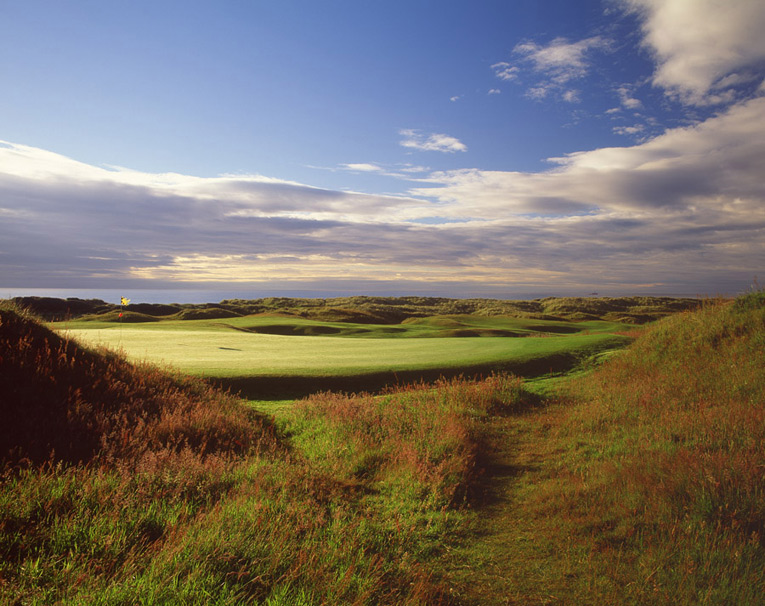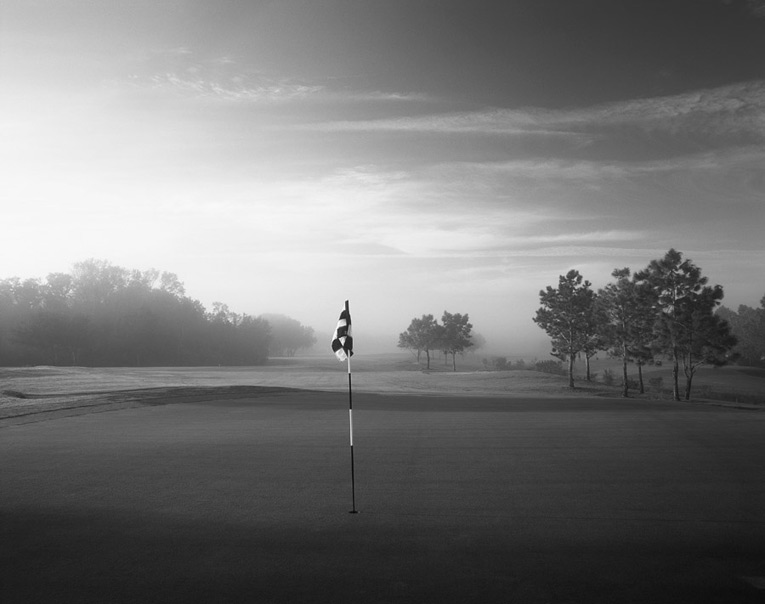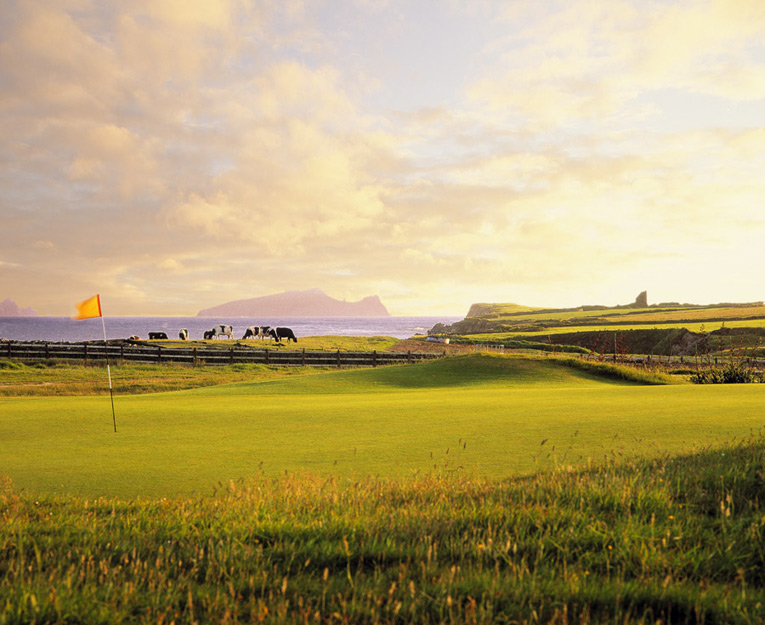Feature Interview with Aidan Bradley
May 2013

Aidan Bradley’s photograph captures the texture and playing attributes of one of the great par 3s in world golf, the 12th at Portmarnock. Nestled into the dunes, its false front sends many a tee ball off the putting surface while the small but deep bunkers mete out a different form of punishment.
How did you get into the art of golf photography?
Well, the abbreviated answer is that after sixteen years of being a commercial photographer I decided to concentrate on something that I was passionate about, golf. Having seen images in the golf magazines I believed that I could do just as well if not better. I put together a business/marketing plan and submitted it to the people that I thought might avail of my services and twenty years later I am shooting grass for a living. A longer and more in depth (and fun) version can be read at http://www.cybergolf.com/golf_news/the_genesis_of_a_golf_course_photographer.
Can you describe your composition philosophy in terms of selecting angles along the line of play vs. choosing the best view regardless of whether it might be disorienting?
I select my angle based on what I believe will allow me to create the strongest image. Some people, including some on this site believe that for it to qualify as a good golf course image it should be shot from the tee box, from one hundred and fifty yards out and in the middle of the fairway and not from behind or to the sides of the green. It has been called “from the player’s perspective”. However, the average player (non tour) does not play from the middle of the fairway. They are in the rough, over the green, behind a rock or tree. If you wish to “document” a golf course you can walk from tee box to green and “snap” a shot every fifty yards. If you wish to “create” an image that will stop the viewer, reader, long enough to read the copy and inquire where that course is, you have to have a more thoughtful approach that is going to yield something special. That said, sometimes that is achievable from the tee box. However the most important factor to consider before you create the image, is who is cutting the check. Who do I have to make look good. Thank you Keith Foster for the valuable lesson.
Does the playability or shot value for a player influence your selection as to which holes to photograph?
No. The light and the content do.
How many different countries have you photographed in?
To date, thirteen.
You were born in Cork so it is not too terrible of a surprise to find that Irish golf courses enjoy a separate section on your web site. Do the landforms and quickly changing weather help make Ireland a unique place to photograph?
I have photographed courses in several unique and interesting places. The Outer Hebrides, The Azores, The UAE and a few Caribbean countries. I wouldn’t say that Ireland is unique inasmuch as there are a few other countries that have similar terrain and weather. However, Ireland is very special and dear to my heart as I spent the first twenty two years of my life there. The unpredictability of the weather is a double edged sword. It can give you stunning light and cloud formations or it can confine one to the tavern for days on end waiting for a glimpse of sunshine. Over the years I have spent a total of eleven days at Ballyliffin and have yet to finish the project. Its comforting to know that you can get up in the morning and you can go to work as opposed to sitting around spending your hard earned few shekels. That is the down side of planning a photography trip to Ireland. Needless to say the genuine warmth of the people, hearty soups, roaring fireplaces and an abundance of “mothers milk” to fuel many a lengthy conversation all add to Ireland’s lustre.
What are five ‘hidden gem’ courses that surprised you in terms of their overall merit and ambiance?
Not the easiest of questions as nothing is is “hidden” anymore but I will take a stab at it. Gary Player’s Costa Baja in La Paz comes to mind. I think its “overall merit” is that I found it eminently playable but moreover, lots of fun. With stunning views of the shimmering waters of the Sea of Cortez, it certainly did not lack any ambiance.
Dooks, in the South of Ireland is situated in a delightful part of the country. While not necessarily considered as one of Irelands premier courses it is most definitely a gem. While the stunning scenery may lull one to sleep the variety and challenge of the holes will keep you on your toes. The vegetable soup and toasted sandwich washed down with a creamy pint is the perfect punctuation on a wonderful golfing experience.
By virtue of its remoteness and history and because Ralph Thompson will have me fleeced if I don’t mention it, I would include Askernish in this group. In terms of conditioning, it’s certainly no Augusta but for those who have made the pilgrimage can attest, it’s golf as it was meant to be.
Even though it may lurk in the shadows of Royal Aberdeen, Cruden Bay and Mr. Trump’s latest effort, Murcar is a delightfully fun course. I would definitely consider it a hidden gem and can’t wait to play it again.
I have just noticed that all the courses that I have chosen happen to sit next to a large body of water and none are in America. Lest Gib gets his “pink panties in a wad” (his words not mine) and reports me to the INS, I have chosen Arrowhead in Littleton, Co as my final choice. With its jagged red rocks it is one of the most stunning amphitheaters within which to play golf.
What sort of camera equipment do you use? Specifically please touch on different lens and filter combinations our readers might be interested in trying.
Over the years I have photographed with every different format. 8×10, 4X5, 2 1/4 x 2 1/4, 6×7, 6×17 and 35 mm. At present I use a Canon 5D Mk 2. The lens’s are 17-40, 24-70, and 70-200. My lens of choice is the 24×70. I only use one filter and that is a warming cross polarization filter. Other thoughts on what I think it takes to create a good golf course image are available in the following article….. http://www.cybergolf.com/golf_news/the_art_of_golf_course_photography
Does pixel count make a difference in quality golf photography?
You may be surprised to hear that as someone who makes his living from shooting grass I am the least technical person you will ever meet. I know if I put gas in my car and change the oil at the appropriate time it will get me from A to B. I have no idea how a car works. My wife probably knows more than me. Similarly, with my cameras, I see something in my minds eye, I point the camera at it and push a button. Voila! I don’t feel the need to know how it captured the image, just that it can. The simple answer to your question based on my limited knowledge is that pixel count is important but only up to a point. If you are going to make a large print (20X28) you obviously will get a sharper result from a 60 mgb file than a 6 mgb file. Quality of the lens is very important as well as the size of the sensors. For those who are more knowledgeable than I (Gib) please feel free to enlighten me.
What are your thoughts on modern film stocks vs. digital technologies? Under what circumstances do you use one over the other?
Until I switched to digital I used Fuji Velvia film. I loved it and would still be using it today if not for making the change. Because of my foreign travels where I would be on the road for up two months and the number of airport xray machines I had to pass through, I was forced to switch to digital. I went dragging and kicking. Keeping the film cool for two months was a problem. Telling a client they would have to wait for a couple of months before I delivered the final product was an issue. Of course, the denigration of the film from all the passes thru the xray machine was a major concern. I now shoot digitally exclusively.
When do you opt to use B&W vs. Color?
Never. I can always convert to B&W later.
Does your approach differ based on the landscape? If so, what adjustments to you make between shooting Links, Parkland and Desert courses?
My approach never changes. I always want to get the best out of every shoot irrespective of whether it is a blonde , brunette, or redhead. I want to create some iconic images that give a “sense of place” . The difference may be in the approach. As a rule, with a links course, assuming you have sunshine you have it from sunrise until sunset. So you have access to the softest and warmest light. Pretty much the same with a desert course unless it rises or sets behind a mountain. Parkland courses for the most part are tree lined which means that you have to wait for the sun to get above the trees to illuminate the green and the flag and the converse is true in the afternoon. You have to shoot the hole when the sun is higher in the sky and hence brighter, more harsh which tends to make the final image more contrasty (blocked shadows).
What course are the most difficult to capture? Parkland courses that are a sea of green?
Yes, to a certain extent. Courses that lack variety. Courses where every hole is a tunnel with a flag at the other end. Courses surrounded by homes. Courses in Canyons.
What is your philosophy with respect to including golfers in your compositions vs. shooting pure landscape?
I only include people if it is required. I believe when someone looks at a golf landscape it should be a personal moment. You should be able to close your eyes and hear the birds sing, you should feel the dew on the grass, you should hear the sound of a perfect wedge to the green land softly and run up to two feet from hole. To include people in the image robs one of this experience.
Please explain the process of image creation from start to finish.
Once I have decided on the scene I wish to capture I create three versions. One normal exposure, one a half stop over and the other a half stop underexposed. When I return to my hotel I download all the raw files from the flash card to a folder on my laptop. I then copy that folder to an external drive. This should always be completed before enjoying an adult beverage. I now have three copies of all my files.
Once back home I make a duplicate copy on my main external drive which is attached to my mothership computer. After I have uploaded the new folder to my computer I open the files in “Bridge” which works in conjunction with Photoshop. I select the preferred exposure and then make some minor alterations. I usually add a little warmth (temperature), I can if need be alter the exposure a little (usually fine) and I can recover some highlights (blown out skies). I apply a little clarity (sharpening) and vibrance as raw files tend to be a little flat and not as sharp as if they had been shot in Jpeg mode. Then I open the file in Photoshop.
This is where the cosmetic alterations occur. Basic stuff like cleaning up divots, rake removal and whatever dodging and burning one deems appropriate to make the product the best it can be. There is a fine line one can cross where you either have a natural beauty or a painted lady. You don’t want to go there because once the mascara starts to run you have ruined the image. Less is more. Once I sign off on the image I add a little sharpening and then embed all the pertinent information in the metadata in the file. The files are then sent to the client and added to my external drive. I have copies of my image library in my house, in a local bank vault, in an undisclosed location in Northern California and finally in Europe lest I am at thirty thousand feet and Southern California falls into the Ocean. These are constantly being updated.
In terms of post-production, how much of the final product is the result of computer/lab modifications?
It will vary from shot to shot but hopefully very little and none at all if possible. However, that said, there are times when it becomes an integral part of the final product which could not have been achieved without the help of some digital magic. Case in point. Many years ago I was commissioned to photograph 3 Creek Ranch in Jackson Hole , WY. The course wasn’t due to open until the following Spring but I had to shoot the course the Sept of the prior year. Needless to say the course was not ready to be photographed but with the winter snows impending and the client wanting to get a jump on the marketing material, it had to be photographed early.
Other simple chores like cleaning up the divots on a tee box or removing rakes from bunkers are considered common maintenance. In the old days when I was a studio shooter if the client arrived with a product that was slightly flawed we would have to send for a new sample which might take hours or a day or two. Now we can fix it in post in five seconds. Post production alterations have their place in modern day photography (not photojournalism) but to be used sparingly and only when necessary IMHO.
What post-production tools do you use? Photoshop? Aperture?
Photoshop.
Do you shoot all of your digital photos RAW?
Yes.
What is the future of golf course photography? Is 3-D the next step?
As I said earlier I am not a very technical person when it comes to the tools I use. I know what I like to achieve and I find a vehicle that will get me to that place. With regards to 3D photography going mainstream I do not believe it is in the immediate future but I do believe it will be part of the photographic future. I think we will have to have pretty powerful processors in our computers and other gadgets to allow us to view the final image as we do now. That like everything else is just a matter of time and money. I would be happy to create a 3D golf course image and then if everyone on GCA spent $500 to get those fancy glasses we could start a new thread to discuss the merits thereof.
Do you prefer morning or afternoon light?
Afternoon light. When there is no dew, or frost, or maintenance workers and it is closer to cocktail hour.
Do you watch weather forecasts for deciding when to photograph? I suppose once you travel to a remote site, you’re stuck with whatever the clouds dish out?
Before I book the dates I always check with several weather sights and sometimes with the Superintendent as he/she may have a better idea with the help of local radar and local knowledge. As I have said before course photographers are like race horses, they can’t wait to get going but when you can’t even get out of the blocks it is very frustrating. There is no doubt but that we are at the mercy of the weather. All one can do is stack the percentages of success in our favour and after that, keep your fingers crossed. However, when I go visit Ralph Thompson again this Summer in the Outer Hebrides if I am stuck there for days because of inclement weather I will just make the best of it. I will will drink all his Highland Park and feed daily on the lovely local Salar Salmon. Life will be good.
There is no better way to end a Feature Interview with an Irishman than to ask him for a few of his favorite shots from around Ireland. Please provide!
With pleasure. Please see the following: The 14th on the Old Course at Ballyliffin, the 3rd at Ceann Sibeal in Dingle and last but not least, a fine Irish gent!
THE END




















